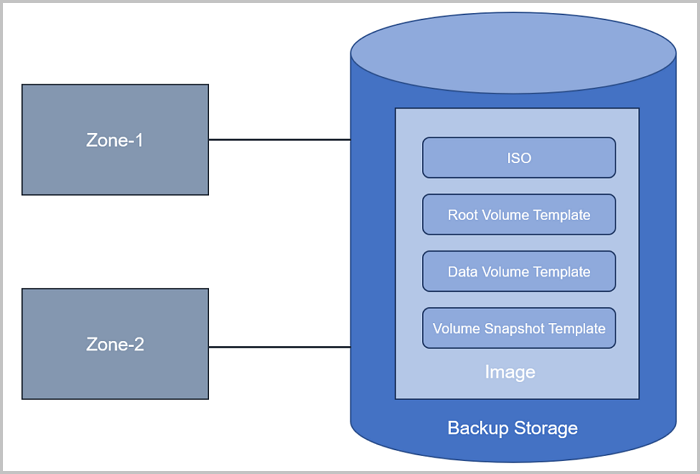What is Backup Storage?
A backup storage is one or more servers that store VM image templates, including ISO image files.
- A backup storage must be attached to a zone before the resources in the zone can
access it. Note that you can share images across multiple zones by using the backup storage.
Figure 1. Backup Storage 
- To better manage backup storages and zones, the UI specifies that one backup storage can only correspond to one zone. In the UI, when you add a backup storage, the backup storage will be attached to the current zone by default. When you delete a zone, the backup storage attached to the zone will also be deleted.
Backup Storage Type
The Cloud supports the following types of backup storage:
- ImageStore
- Stores image files by means of image slices and supports incremental storage.
- Allows you to create snapshots and images when VM instances are running or stopped.
- Allows you to clone VM instances without data volumes when these VM instances are running, paused, or stopped.
- Allows you to clone VM instances with data volumes when these VM instances are running, paused, or stopped, and with storage types of LocalStorage, NFS, SharedMountPoint (SMP), Ceph, or SharedBlock.
- Supports image synchronization across ImageStore backup storages on the same management node.
- Allows you to obtain the existing image files under the URL path in the backup storage.
- Ceph
- Stores image files by means of Ceph distributed block storages.
- Allows you to create snapshots and images when VM instances are running or stopped.
- Allows you to clone VM instances without data volumes when these VM instances are running, paused, or stopped.
- Allows you to clone VM instances with data volumes when these VM instances are running, paused, or stopped, and with the storage type of Ceph.
- Allows you to export images on the UI or backup storages.
- You can export images, copy exported image URLs, and download exported images on the UI.
- You can also export images on a backup storage.
For example, assume that the image path you use is ceph://bak-t-c9923f9821bf45498fdf9cdfa1749943/61ece0adc7244b0cbd12dafbc5494f0c.
Then, run the following command on the backup storage:rbd export -p bak-t-c9923f9821bf45498fdf9cdfa1749943 --image 61ece0adc7244b0cbd12dafbc5494f0c --path /root/export-test.image # bak-t-c9923f9821bf45498fdf9cdfa1749943 is the name of the pool where the image resides. # 61ece0adc7244b0cbd12dafbc5494f0c is the name of the image. # /root/export-test.image is the name of the exported file.
- AliyunEBS
- Stores image by means of object storages.
- Allows you to create snapshots and images when VM instances are running or stopped.
- Allows you to clone VM instances without data volumes when these VM instances are running, paused, or stopped.
- Does not allow you to clone VM instances with data volumes.
- Allows you to export images on backup storages. For more information, contact the official technical support.
Backup Storage | Primary Storage
The following table lists the relationship between primary storages (PS) and backup
storages (BS).
| PS/BS | ImageStore | SFTP | Ceph |
| LocalStorage | ○ | ○ | × |
| NFS | ○ | ○ | × |
| SMP | ○ | ○ | × |
| Ceph | ○ | × | ○ |
| SharedBlock | ○ | × | × |
- When primary storages are LocalStorage, NFS, or SMP, the default type for backup storages is ImageStore.
- When primary storages are NFS or SMP, you can manually mount the corresponding shared directories to the local directories of the corresponding backup storages. In this regard, both primary storages and backup storages can use the network shared storage.
- When primary storages are Ceph, you can use the primary storages in the same Ceph cluster as backup storages. You can also use the ImageStore primary storages as backup storages.
- When primary storages are SharedBlock, the default type for backup storages is ImageStore.
- When primary storages are AliyunNAS, the default type for backup storages is ImageStore.
- When primary storages are AliyunEBS, the default type for backup storages is AliyunEBS.